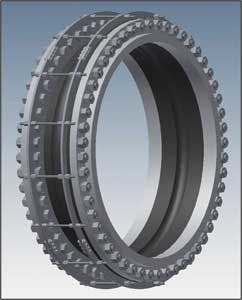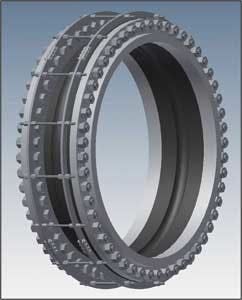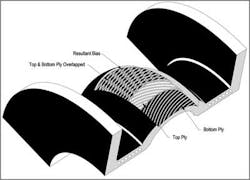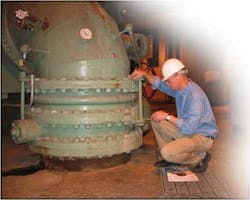By Lloyd B. Aanonsen, PE
Elastomeric expansion joints have long been recognized for their ability to reduce noise and vibration and accept fluctuating thermal movements in piping systems. Recent advancements in engineered elastomers and textiles led to the development of expansion joints with improved performance and operating life. Equally valuable is their unique ability to be installed in offset and misaligned applications. These cost saving features have made the expansion joint a pivotal component in replacement and retrofit projects, as well as in new construction.
In past years, the common expansion joint fabric reinforcement was a square woven cotton or polyester weave. "Square woven" implies that the fabric strands are aligned perpendicular to each other and have approximately the same strength in each direction. If a greater strength were needed in one direction, the engineer would have been forced to increase the overall number of plies, thereby increasing the strength in both directions and consequently the overall stiffness. By using tire cord, the bias angle can be changed to increase the strength in one direction over the other. This is significant because the static forces in an expansion joint are considerably different in the axial versus the radial direction.
Tire cord also ensures a superior rubber-to-fabric bond because it is coated with an adhesive called Resorcinol Formaldehyde Latex (RFL). This RFL coating was developed by the tire industry to prevent ply separation and delamination. The combination of an improved elastomeric bond and an optimal number and angle of plies creates a homogeneous composite with consistent and predictable engineering capabilities.
The greater flexibility of today's joints minimizes stress on the piping system. When the expansion joint accepts thermal movement, it replaces thermal stresses, which can quickly exceed allowable pipe stresses with the stiffness of the joint. Expansion joints can also now be used with a wider cross-section of chemically abrasive and erosive mediums under higher system temperature and pressures.
Building the expansion joint to exact field dimensions addresses another critical problem. In the course of their life span, piping and equipment settle and offset at different rates. A large diameter condenser joint may develop non-parallel flanges and a lateral offset in excess of 2 inches. While the condenser and piping system as a whole have many years of use left, the problem becomes how to bridge this offset. When replacing the valve and expansion joints, it is often cost-prohibitive to realign the piping or equipment. It is also unrealistic to order a replacement valve with varying overall lengths and built-in lateral offsets. It is, however, relatively inexpensive for the expansion joint manufacturer to incorporate these field dimensions into the replacement expansion joint.
Previously, the installation crew spent a great deal of time and effort forcing a straight standard expansion joint into an offset and misaligned location. After an exhaustive installation process, the straight expansion joint had a substantially reduced life due to permanent stresses imposed on it. In some cases, the actual field dimensions exceeded the allowable movement capabilities of the joint, ensuring imminent failure.
Building an expansion joint to exact field dimensions ensures that the full allowable movement capability and useful life are maintained, while minimizing installation and maintenance costs.
About the Author: Lloyd B. Aanonsen, PE, is Chair of Ducting Systems – Non-Metallic Expansion Joint Division for the Fluid Sealing Association and President of General Rubber Corp.






